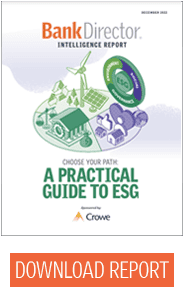
Research Report: A Practical Guide to ESG
Brought to you by Crowe LLP

 For years, investors and activists have worked to compel large, public companies to report their stance on environmental, social and governance issues – better known as ESG. And recently, additional pressure has come from bank regulators on one specific ESG risk: climate. Smaller banks, meanwhile, see the writing on the wall and are taking steps to beef up their ESG programs.
For years, investors and activists have worked to compel large, public companies to report their stance on environmental, social and governance issues – better known as ESG. And recently, additional pressure has come from bank regulators on one specific ESG risk: climate. Smaller banks, meanwhile, see the writing on the wall and are taking steps to beef up their ESG programs.
As regulated entities, banks are no strangers to many elements of ESG, which Bank Director explores in the newly launched research report Choose Your Path: A Practical Guide to ESG, which is sponsored by Crowe LLP. Board structure and composition, cybersecurity and data privacy, risk management and regulatory compliance are all areas that fall under the governance umbrella. Social elements, which include financial access, diversity and community involvement, also incorporate into day-to-day operations as financial institutions comply with fair lending rules and other regulations. But it’s the ‘E’ for environmental – specifically, measuring greenhouse gas emissions – that frustrates some bankers who would rather focus on serving their communities than spending time and resources on that complex assessment.
In this report, Bank Director provides intelligence for bank boards and leadership teams seeking to better understand the current regulatory and investor landscape, and uncover what’s relevant for their own organizations. Inside, you’ll find:
- A quick overview of how ESG has become a language of sorts to describe a company’s activities to investors and other stakeholders
- Where Washington stands on ESG
- How investors have focused their attention
- How banks leverage ESG to uncover new opportunities, including how three community banks have identified core areas that are relevant to their own operations
- Key material matters for banks to prioritize
- What role boards could play in ESG oversight, and questions directors might ask
“[A]s disclosures grow, [investors] have more information to make comparable decisions, and that will just continue to grow because of the regulatory environment,” says Chris McClure, a partner at Crowe who leads the firm’s ESG team.
On Dec. 2, 2022, the Federal Reserve issued a request for comment on proposed principles for institutions over $100 billion in assets. These principles focus on climate-related financial risks: everything from u200bu200bgovernance and policies and procedures to strategic planning and risk management. It’s in line with similar guidance issued by the Office of the Comptroller of the Currency and the Federal Deposit Insurance Corp.
At least one Fed Governor doesn’t believe the guidance is necessary: “Climate change is real, but I disagree with the premise that it poses a serious risk to the safety and soundness of large banks and the financial stability of the United States,” stated Christopher Waller. “The Federal Reserve conducts regular stress tests on large banks that impose extremely severe macroeconomic shocks and they show that the banks are resilient.”
In 2023, the Securities and Exchange Commission is expected to finalize its rule around climate disclosure, adding another element of compliance for all publicly traded companies – not just the biggest banks. While some exemptions are anticipated for smaller companies, the rule would expect companies to share how climate-related risks are managed and governed, along with the material impacts of these risks on operations and strategy. Companies could be required to measure greenhouse gas emissions – including emissions by vendors and clients – and share their goals for transitioning to a greener economy.
At the same time, governments in conservative states are working to oppose these rules, going after banks and asset managers that they believe discriminate against the oil and gas or gun sectors. It’s a tricky environment to navigate. Increasingly, some disclosure will be mandated, at least for publicly traded institutions. But bank leaders will still determine their own strategies for the road ahead – and banks that are successful will find the path that’s right for their organization.
To access the report, click here.
If you have feedback on the contents of this report, please contact Bank Director’s vice president of research, Emily McCormick, at [email protected].

